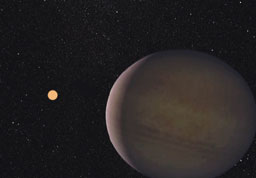
An artist's concept of the Jupiter-mass planet found orbiting a red dwarf star at least 10,000 light-years away in Sagittarius.
NASA / JPL-Caltech.
After years of intense efforts and questionable results, astronomers yesterday announced the first clear-cut detection of an extrasolar planet by a completely new technique. Two large teams working in the Southern Hemisphere jointly announced that they have found a Jupiter-mass planet orbiting a red-dwarf star about 10,000 to 15,000 light-years away. They did it by detecting the slight gravitational pulls that the star and its planet exerted on light coming from an even more distant star in the background.
For almost two decades, astronomers have been intrigued by what they might learn from such gravitational microlensing — the distorting and magnifying of a star's image by the gravity of an object passing nearly in front if it. For microlensing to happen, however, the intervening object must pass extremely close to our line of sight to the star, and this happens very rarely. But computerized monitoring of millions of faint stars has made it possible to find even these rare events.
One of the most successful microlensing searches is named OGLE. Its current version, OGLE-III at Las Campanas Observatory in Chile, is imaging and measuring 200 million stars in the Milky Way's central bulge about once every two days. This gigantic mass of data has been a treasure-trove for variable-star scientists and astronomers hunting for objects that dim a star's light by transiting directly across its face. And just as hoped, the effort has also yielded many cases of stellar microlensing.
Since 1993, searches of this type have recorded almost 2,000 microlensings of one star by another in the direction of the Milky Way's bulge. About 50 of these events have shown complex, double-lens effects caused by a binary lensing object. One extraordinary binary event, seen last July and August, showed a mass ratio between the pair of lensing objects of about 250 to 1 — which means the lighter of the two has to be a planet.
The event (named O235/M53) was detected independently both by OGLE-III and by the similar MOA project at Mount John Observatory in New Zealand. The two not only confirmed each other's detections but filled in each other's data gaps.
"In the past there were several cases of false alarms" about microlensing planets, said team member Bohdan Paczynski (Princeton) at a Thursday press conference. But this time, he averred, "we are absolutely confident that this is it."
The background star whose light got magnified was a normal type-G star, glowing at a dim 20th magnitude far off in the swarms of the Milky Way's central bulge. The lensing star between us and it was probably a type-M red dwarf with about 1/3 of a solar mass. That would give its companion about 1 to 1.5 Jupiter mass and would place the companion 2 or 3 astronomical units from the star as seen projected on our sky.
Another possibility is that the lensing star is a white dwarf of about 0.6 solar mass. That would give its planet the mass of about 2.5 Jupiters.
The lensing star actually can't be seen at all; it's buried in the glare of the brighter background star. But the astronomers estimate that in about 10 years, its proper motion will carry it far enough to one side that telescopes will be able to resolve it and study it directly. Its planet, however, is beyond all hope of ever being detected again — a distinct drawback of the microlensing method of planet-finding.
The fact that only one such event has been found in such a vast search does not mean that Jupiters are rare, Paczynski stressed. The lineup of all the pieces has to be so extremely lucky that finding just one event so far is consistent with Jupiters being common.
Paczynski and Ian A. Bond (Institute for Astronomy, Edinburgh), the lead author of the group's paper, say they are confident that the ongoing microlensing hunts will find and characterize more exoplanets soon. The key, however, will be intensive monitoring as soon as a promising event begins. Well-equipped amateurs, they note, could provide crucial help during these followups.
The most exciting prospect is that this method may find the first exo-Earths. Says Bond, "The real strength of microlensing is its ability to detect low-mass planets."
 0
0
Comments
You must be logged in to post a comment.